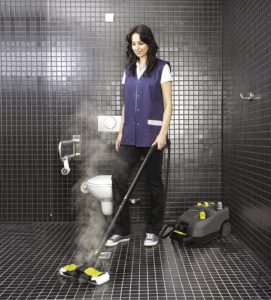Daniel Took, Head of Professional Product Marketing at Kärcher UK explains best-practice cleaning methods for sanitary areas and washrooms.
The cleaning of washroom facilities requires specialist and effective cleaning techniques as moisture and heat in changing rooms and sanitary area environments can harbour microorganisms, which will multiply if left unchecked. Organic substances such as dirt or flakes of skin and hair can form a breeding ground for these microorganisms.
Washrooms can also be subject to special contamination from limescale, soap scum, rust, urine and excrement, which require aggressive cleaning agents that can potentially damage surfaces. It is important to consider the acidic content of the cleaning agent to maintain high standards of cleanliness without causing damage. Always read the safety data sheet as the acids will vary.
Deep cleaning the washroom must factor in all used spaces within the washroom including floors, wall tiles, sinks and mirrors, shower areas, toilets and urinals, as well as the associated fittings. Different reactions to cleaning agents should be expected when cleaning multiple surface materials because of the optimal living conditions for microorganisms (bacteria or fungi).
For maintenance cleaning, a cleaning agent with both a fungicidal and an antibacterial effect is recommended to keep the number of microorganisms as low as possible for the long term.
 General
General
Toilet lids and seats must be treated with an all-purpose or alcohol-based cleaner, as acids can dissolve dye pigments and cause stains. Doors, door frames and separating walls should also be cleaned with all-purpose or alcohol-based cleaner using scratch-free pad sponges. Any furniture in the changing area, such as seating and coat racks, should be manually scrubbed using a light alkaline cleaning agent or everyday cleaner, then rinsed and dried with a yellow cleaning cloth.
In conclusion
The cleaning measures detailed here are effective for ensuring that changing rooms, showers, wellness areas and saunas or fitness facilities remain clean and hygienic, maintaining the wellbeing of visitors and the positive reputation of your facility. Important note: sanitary cleaners must be used as directed and in accordance with accident prevention guidelines. This means wearing protective gloves and eye protection if necessary. Never mix cleaning agents, pay attention to the prescribed dosage, do not use warm or very hot water and rinse well with clear water.




